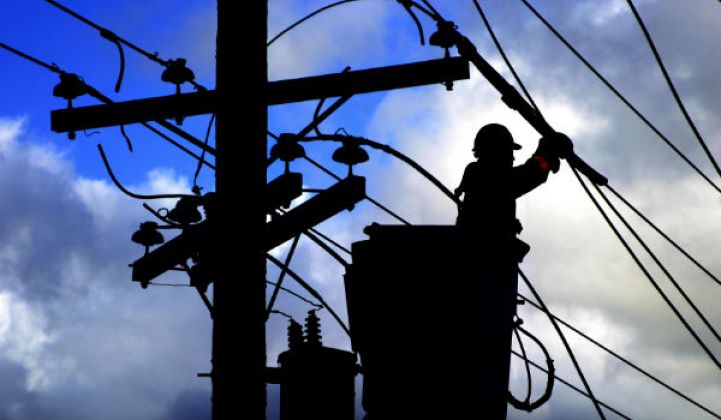The electric utility industry’s central criticism of distributed solar is that it creates a “cost shift” from rooftop solar customers to non-solar customers. This isn’t entirely true, because most solar customers cover the cost for utilities to serve them, thus shifting no costs. A study commissioned by the California Public Utilities Commission found that across the state’s three investor-owned utilities, solar customers pay on average 103 percent of the utilities’ cost to serve them. The cost to serve covers not only transmission and distribution, but also regulatory costs such as nuclear decommissioning and public-purpose programs.
Solar customers continue to pay utility bills after going solar that are on par with those of many utility customers who do not go solar. It does not make sense to treat two utility customers differently from one another if they pay the same utility bill, and they both cover their cost of service, but one of them arrives at that level of utility power consumption in part by having solar on her roof.
Meanwhile, these solar customers not only pay their fair share but also reduce the utilities’ cost to serve neighboring homes. In 2014, a study for the Nevada Public Utilities Commission found that solar customers provide a net benefit to all ratepayers. A study commissioned by the Mississippi Public Service Commission came to the same conclusion. The primary direct benefits (not including job creation or environmental benefits) include savings on the costs of energy and generation capacity, savings on costs associated with maintenance and upgrade of transmission and distribution infrastructure, transmission losses, and compliance with state renewable portfolio standards.
Rooftop solar creates a small revenue shift -- and a massive innovation incentive for utilities
While there is no cost shift, utilities do face a revenue shift as more people go solar. This revenue shift, while of some understandable concern for utilities, is relatively minor - especially in the face of the urgency with which renewable energy must be deployed to slow CO2 emissions. Based on a 2014 study by consulting firm Accenture, in a likely scenario in which both distributed solar and everyday energy efficiency efforts continue to grow in popularity, utilities would face a resulting revenue loss of less than 3 percent through 2025.
The regulated utility was born out of a public compact -- utilities invest in building infrastructure to serve the public, and regulators ensure that utilities earn a reasonable (but not excessive) rate of return on those investments. Today, utility rate on equity is often 10 percent. Most of the modern utility’s profit comes from building transmission and distribution projects, and the utility’s profit incentive is essentially to build more forever, with little inherent incentive to become more efficient. This focus on building more in order to recover more is in direct conflict with the public's interest in having a more affordable system.
The imbalance of information between regulated firms and regulators can be balanced with market forces
In October 2014, economist Jean Tirole was awarded the Nobel Prize for his work on regulated monopolies. Tirole found that “the regulatory authority lacks information about the firms’ costs and the quality of the goods and services they deliver. This lack of knowledge often provides regulated firms with a natural advantage.”
With regulators therefore at a disadvantage, how can they effectively control prices, and make decisions that are in the public interest? One option is to embrace competition as the countervailing force against asymmetric information. The revenue shift caused by solar PV should motivate utilities to lower rates, not to raise them. Regulators could also open up grid services to competitive markets to motivate utilities to seek out lowest-cost options and adopt innovative technology.
To take advantage of distributed energy resources, utilities should be allowed to rate-base infrastructure-as-a-service
At present, the unnecessary distinction between physical infrastructure (which can be rate-based) and services (which can’t) prevents utilities from embracing the benefits of rooftop solar. For example, imagine a utility that showed regulators that by purchasing services on the distribution system, such as capacity, power quality, voltage control, and frequency support, it could avoid capital investments in infrastructure. Whereas the infrastructure investment might cost ratepayers $12 per kilowatt per month over the depreciation period, utilities might be able to procure equivalent services from distributed resources such as solar power with smart inverters and batteries through a competitive market for just $10 per kilowatt per month. This very phenomenon is playing out in information technology with cloud-based computing. Companies are increasingly paying for services on a monthly basis from companies like Amazon and Google rather than buying physical equipment to create their own data centers.
There are encouraging signs. Rather than build a new substation at a cost of $1 billion, New York City-based utility Con Ed plans to invest in demand-side management programs (distributed solar generation) and substation upgrades to reduce its load by 52 megawatts by 2018, at significantly lower cost to ratepayers. Additionally, California’s Distribution Resource Plans and New York’s Reforming the Energy Vision (REV) proceedings are two important regulatory dockets that will continue in 2015. Both acknowledge the utilities’ revenue diminution dilemma and seek to realign incentives to accept and encourage clean distributed generation resources to the benefit of everyone, including utilities, clean energy providers, and consumers. In tandem, it will be important to unlock new markets that reward the implementation of innovative services over inefficient and outdated ratepayer-financed infrastructure.
***
Peter Rive is CTO and co-founder of SolarCity. This column was posted on the the SolarCity blog today and reprinted with permission.



